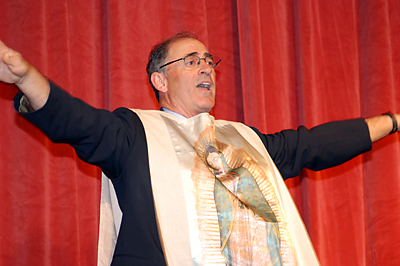
 ANDERSON — A missionary image of Our Lady of Guadalupe made a 10-day pilgrimage to South Carolina in mid-October, accompanied the second week by Dan Lynch.
ANDERSON — A missionary image of Our Lady of Guadalupe made a 10-day pilgrimage to South Carolina in mid-October, accompanied the second week by Dan Lynch.
Lynch, a retired judge from St. Albans, Vt., is director of The Missionary Image of Our Lady of Guadalupe apostolate, www.jkmi.com. He travels the world speaking at retreats, conferences and missions. The digital version of the cloak of St. Juan Diego, which hangs in the Basilica of Our Lady of Guadalupe in Mexico City, usually travels via guardians to local communities.
“There are actually four of these images and we keep them going,” Lynch said. “When the image went to Charleston last week for a prayer vigil outside an abortion clinic, your new bishop [Most Rev. Robert E. Guglielmone] was there. His witness should give you strength.”
The visit to South Carolina by Lynch and the missionary image was sponsored by the parishes in the Diocese of Charleston where it was shown.
Pope John Paul II called Our Lady of Guadalupe the mother of hope, according to Lynch, and 80-year-old Connie Makay felt just that when she venerated the image at St. Joseph Church on Oct. 16.
“There’s a lot of feeling coming from her, as if Our Lady is really a part of you. I put my trust in her,” Makay said.
Lynch spoke of the peasant Nahuatl named Juan Diego Cuauhtlatoatzin, who was called by the apparition of a woman on Dec. 9, 1531, as he walked to Mass in the cold pre-dawn.
“She called him Juanito, Johnny. ‘Come to the top of Tepeyac Hill,’ she said. He went and saw that the light from her had turned the cactus to flowers and the desert rocks to jewels. Juan Diego was stupefied. Our Lady told him to go to the bishop and ask that a church be built on the spot. He said: ‘Why me? I’m just an Indian; he’s not going to believe me.’ But he went.”
Bishop Juan de Zumarraga, the protector of the indigenous people, did not believe him. The bishop witnessed the fighting between the Nahuatl and the Conquistadors, and prayed for an end to it.
The lady sent Juan Diego back to the episcopal palace again. This time, Bishop Zumarraga asked him to bring a sign. Mary agreed to give him one the next day. But Juan Diego’s uncle turned deathly ill and the man missed his date with her.
“Imagine standing up the queen of heaven. On Dec. 12, he went to get a priest for his dying uncle. He tries to sneak around the Lady but she appears before him. She tells him, ‘Be not afraid,’ a message for all of us,” Lynch said.
Mary told Juan Diego that his uncle was cured, and the man was healed at that very moment. Then she sent Juan Diego back to the bishop with a cloak full of Castilian roses, which were mysteriously growing on Tepeyac Hill. It was winter and that type of flower had never grown in Mexico before.
St. Juan Diego’s cloak, called a tilma, was an all-purpose garment woven from cactus fiber. Lynch acted out the story of the miraculous appearance of the image of Our Lady of Guadalupe with a tilma and roses. He had a duplicate cloak with the image concealed by a Velcroed flap that he ripped open when he came to the part of the story where Bishop Zumarraga falls to his knees at the sign.
“It became the greatest evangelization event in the history of the church,” Lynch said. “The Indians, who thought they were nothing, realized that the mother of God had come to them. They began coming to Mass in droves. In nine years, nine million Aztec converted to Christianity and Mexico saw the end of human sacrifice. It proves the power of faith,” Lynch said.
Heesun Devlin coordinated the 12 visits of the image to South Carolina.
